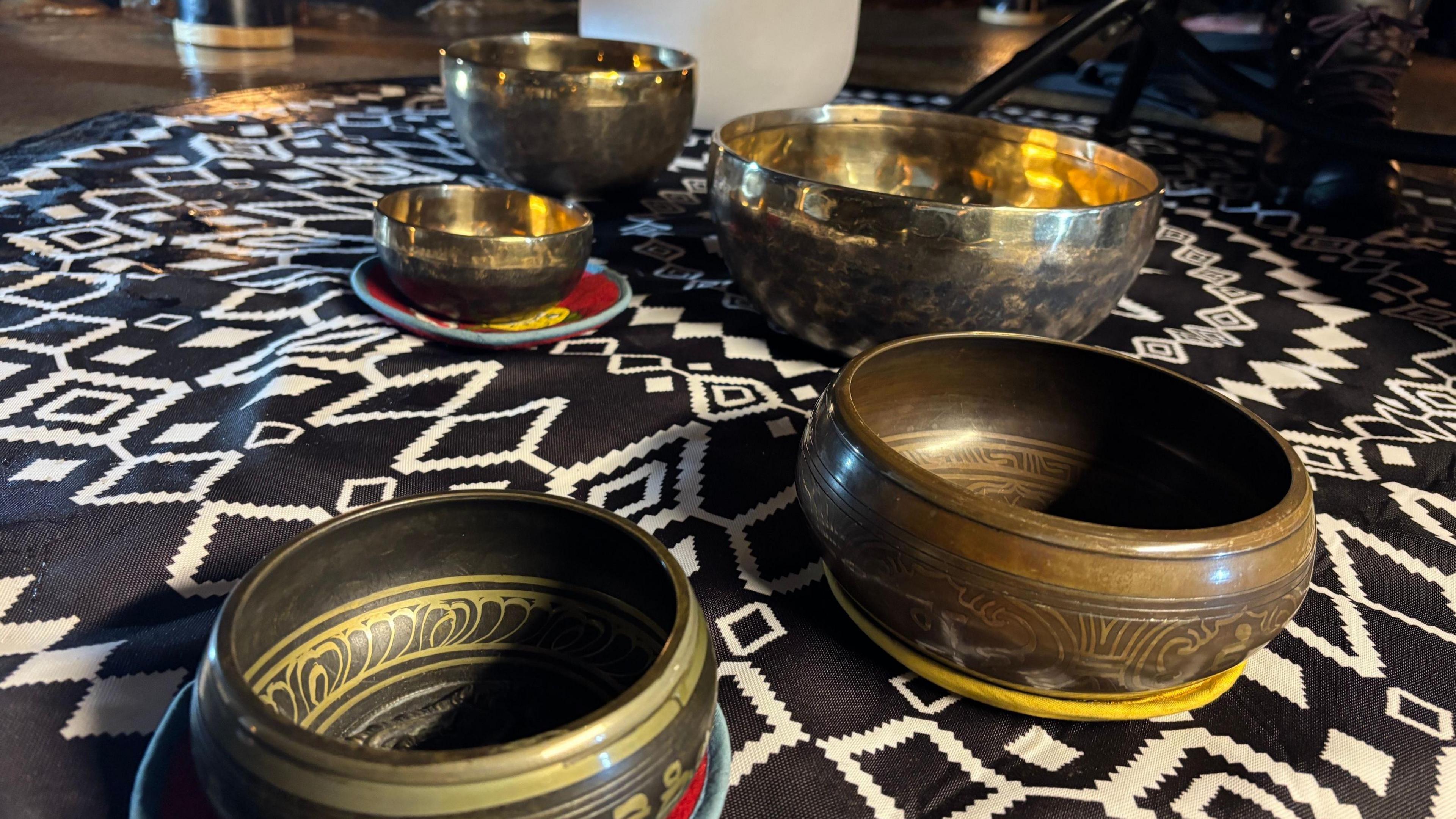Creating an ASMR soundscape for 330 million-year-old caves

Tibetan and crystal singing bowls, gongs and rain sticks were used to capture the essence of the 330 million-year-old cave network
- Published
Sixty-five thousand people visit the Marble Arch Caves every year to see its ancient underground passages and striking limestone formations.
Now a new tourism initiative hopes to entice even more people by using the online phenomenon ASMR - or Autonomous Sensory Meridian Response.
ASMR is a tingly, deeply relaxing sensation triggered by certain sounds and has become an online hit, with millions of people searching out ASMR videos and audios to unwind and de-stress.
The County Fermanagh caves are one of several locations featured in Tourism NI's Giant Awakening campaign which will showcase natural soundscapes from around Northern Ireland.
Creating 'sound journeys'
Capturing the essence of the 330 million-year-old cave network fell to sound therapist Tessa Ann, founder of The Sound Healing Spa.
She specialises in creating immersive "sound journeys" using Tibetan and crystal singing bowls, gongs and rain sticks.
"Sound can help people slow down and really connect with their surroundings," she said.
"When you sit and listen, your ears begin to tune in not just to the instruments, but to the natural sounds of the cave itself.
"It's like a bridge between relaxation and awareness."

Tessa Ann leads the way into the Marble Arch Caves to capture it's soundscape
Tessa Ann visited the caves three times to help her channel the acoustics.
"Some sounds will reflect the space, others will stand apart from it," she explained.
"That contrast helps people to distinguish, to listen more deeply, and to connect more fully with the place."
Tessa Ann found that the caves were rich in sounds that work well for those looking an ASMR hit.
"Sound wise, there are elements that are more reflective," she added.
"There are elements that are more cavernous - where all of a sudden things will just seem very amplified, and then there are other parts of the caves that will just really quieten the sound down.
"Some creates waves or sound waves washing over, or tingles in the body as well that are quite nice. Many of the sounds will create these different feelings and sensations".
Capturing the ever-changing caves
Stephen Cox, manager of the Marble Arch Caves, said the ASMR collaboration offers a new way to experience the site.
"The caves were formed more than 330 million years ago," he said.
"They're completely shaped by nature, by the water and the rock around us.
"Every day is different depending on the water levels and the echoing of the chambers.
"Sometimes it's quiet and calm, and other days you have the roar of waterfalls and drip of rain coming through the limestone."

He hoped the project will introduce the Marble Arch Caves to a new audience.
"It's about connecting people with the natural world in a new way," he added.
"ASMR is hugely popular right now and if someone listens to these sounds and feels relaxed or inspired maybe they'll want to come here and experience it for themselves."
An escape from the digital world
The Marble Arch Caves is already a key attraction in Northern Ireland's Geopark network, bringing in about 65,000 visitors a year - with more than 120,000 people visiting the wider site, including the 'Stairway to Heaven' Culcaigh Boardwalk.
"People love that there's no phone signal down there," Mr Cox said.
"It's one of the few places you can completely switch off.
"You go underground, relax, connect with nature and come back recharged".

Tessa Ann used Tibetan and crystal bowls to tap into the unique sound of the caves
The ASMR recording was produced by Belfast-based Redcap Productions and Felbryn Studios, and will also showcase sounds from other Northern Ireland landmarks like the Giant's Causeway and Glenariff Waterfall in County Antrim, and St George's Market in Belfast city centre.
Tourism NI said the "cinematic" production highlights both the tranquillity and the adventure of Northern Ireland's landscapes.
For Tessa Ann, this has been a dream job - the chance to showcase the healing potential of sound in spectacular settings.
"The caves have their own acoustics, their own atmosphere and their own story," she said.
"When people come here and take time to listen they're not just hearing sound they're hearing the history of the earth itself."
How does ASMR work?
ASMR is a sensory experience, which can be triggered by certain sounds, sensations or visuals, often producing a tingling sensation that often starts from the scalp and moves down to the neck and spine.
The term only became mainstream around 2010, but its popularity has seen more people become interested in the topic.
There are also links to ASMR being associated with feelings of calmness and relaxation, leading some people to watch these kinds of videos or listen to ASMR audio before bed.
Related topics
- Published16 March 2019

- Published16 December 2015
